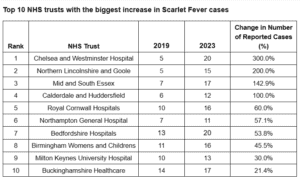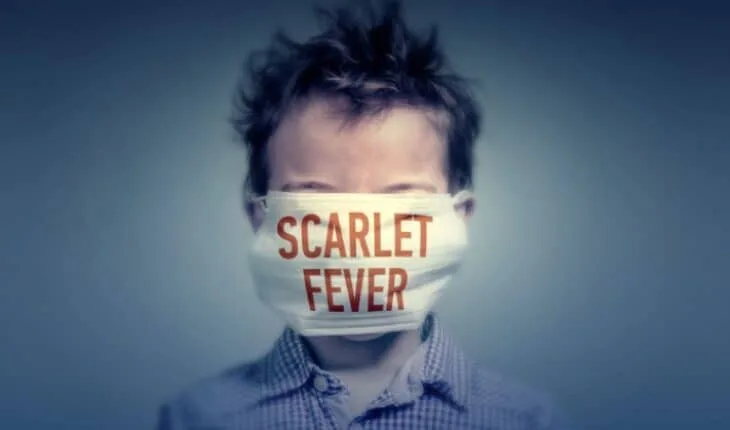Scarlet fever, a disease associated with the Victorian era, has resurged in the UK. As such, recent research has revealed the regions within the UK that have seen the most significant increase in cases.
Health experts at NowPatient submitted Freedom of Information (FOI) requests to NHS trusts across the country to reveal which areas have seen the biggest increase in Victorian diseases such as gout, rickets, tuberculosis, malnutrition, malaria and scarlet fever, as well as analysing search data to reveal which areas of the UK have the most curious residents when it comes to these illnesses.
You can view the full research here – https://nowpatient.com/health-news/the-return-of-victorian-diseases
Top 10 NHS trusts with the biggest increase in Scarlet Fever cases

With a 300% increase in reported cases of scarlet fever, the most significant change in cases belongs to Chelsea and Westminster Hospital.
Next on our list is Northern Lincolnshire and Goole. This NHS trust reported 15 cases of scarlet fever last year compared to just five back in 2019, equating to a 200% increase.
Because Mid and South Essex is one of the biggest NHS trusts in the country, it may be surprising that it has only seen 17 reported cases of scarlet fever throughout 2023. Having said this, cases here have spiked by almost 143% since 2019, the third highest of any NHS trust.
The research has also revealed:
Liverpool University Hospitals was named the NHS trust with the biggest increase in malnutrition cases at 446.8% and gout cases at 960.4%.
Manchester University has seen an increase of 377.8% in malaria cases, which is more than any other NHS trust.
Kettering General Hospital has seen the biggest increase in tuberculosis cases at 238.9%, while East Kent Hospitals University has seen an increase of 380.3% in rickets cases – more than any other trust.
Between February 2023 and March 2024, over 200,000 searches were carried out for ‘whooping cough vaccine’, which is more than any other vaccine-related search term.
Navin Khosla, Pharmacist at NowPatient has shared the following about how to spot the symptoms of scarlet fever::
‘Scarlet fever, once a significant threat to public health, particularly in Britain’s early 20th century, has witnessed a remarkable decline not only in cases but also in severity and mortality rates over the past century – though it has not been completely eradicated.
Caused by the group A strain of the streptococcus bacteria, scarlet fever presents with a distinct set of symptoms, typically starting with flu-like manifestations such as high fever, sore throat, and swollen neck glands. However, its telltale sign is the appearance of a rash, characterised by small, raised bumps initially appearing on the chest and abdomen before spreading across the body. This rash imparts a rough texture to the skin, resembling sandpaper, often accompanied by a white coating on the tongue, which subsequently peels away to reveal a swollen, red surface speckled with tiny bumps, also known as “strawberry tongue.”
While scarlet fever predominantly affects children, it can also affect adults, albeit less frequently. Early recognition of symptoms is crucial, as timely administration of antibiotics plays a pivotal role in preventing further complications and reducing the risk of transmission. Despite its contagious nature, scarlet fever is generally not deemed a severe illness today, given appropriate medical intervention. However, rare instances of invasive Group A Streptococcal disease (iGAS) can pose significant health risks, including septic arthritis, pneumonia, meningitis, and toxic shock syndrome.
In recent years, despite the overall decline in severity, scarlet fever has emerged as a concern once more, with a notable resurgence in reported cases. Therefore, early recognition of signs is imperative, as it minimises the potential for complications and ensures effective containment of the disease within communities.’
- Gut microbiome could delay onset of type 1 diabetes - 3rd April 2025
- The da Vinci 5 Robot Is Set To Transform Bariatric Care: - 31st March 2025
- Beyond money: the hidden drivers fuelling child food insecurity - 31st March 2025






